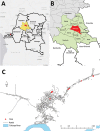Extended Human-to-Human Transmission during a Monkeypox Outbreak in the Democratic Republic of the Congo
- PMID: 27191380
- PMCID: PMC4880088
- DOI: 10.3201/eid2206.150579
Extended Human-to-Human Transmission during a Monkeypox Outbreak in the Democratic Republic of the Congo
Erratum in
-
Correction: Vol. 22, No. 6.Emerg Infect Dis. 2016 Oct;22(10):1862. doi: 10.3201/eid2210.C22210. Emerg Infect Dis. 2016. PMID: 27598564 Free PMC article. No abstract available.
Abstract
A >600% increase in monkeypox cases occurred in the Bokungu Health Zone of the Democratic Republic of the Congo during the second half of 2013; this increase prompted an outbreak investigation. A total of 104 possible cases were reported from this health zone; among 60 suspected cases that were tested, 50 (48.1%) cases were confirmed by laboratory testing, and 10 (9.6%) tested negative for monkeypox virus (MPXV) infection. The household attack rate (i.e., rate of persons living with an infected person that develop symptoms of MPXV infection) was 50%. Nine families showed >1 transmission event, and >6 transmission events occurred within this health zone. Mean incubation period was 8 days (range 4-14 days). The high attack rate and transmission observed in this study reinforce the importance of surveillance and rapid identification of monkeypox cases. Community education and training are needed to prevent transmission of MPXV infection during outbreaks.
Keywords: Africa; Democratic Republic of the Congo; animal diseases; incubation; monkeypox; monkeypox virus; orthopoxvirus; transmission; viruses; zoonosis.
Figures




References
-
- Jezek Z, Fenner F. Human monkeypox. Monogr Virol. 1988;17:111–24.. 10.1159/000416463 - DOI
LinkOut - more resources
Full Text Sources
Other Literature Sources

